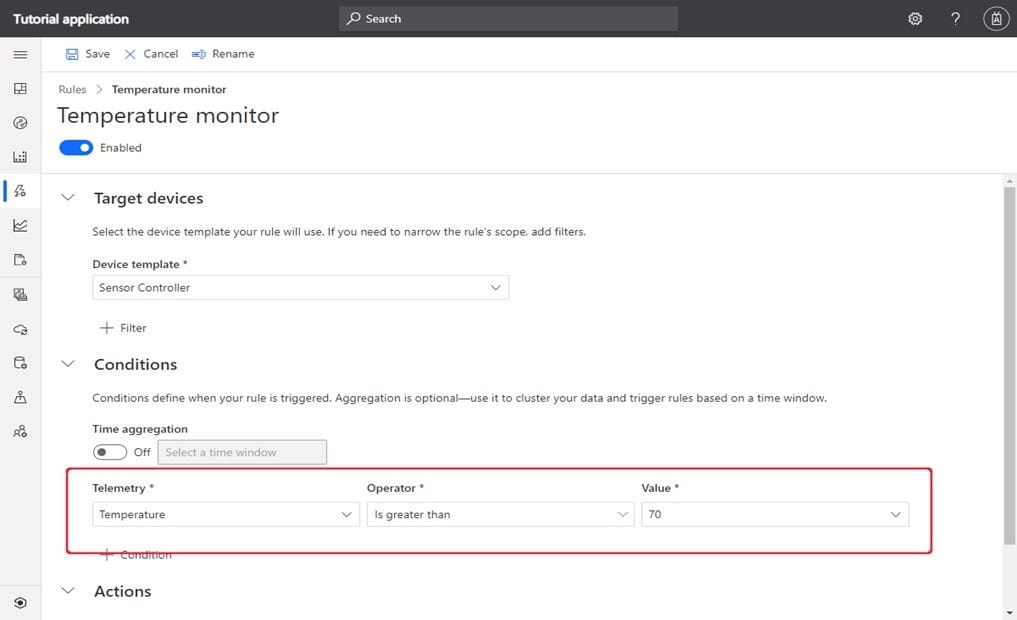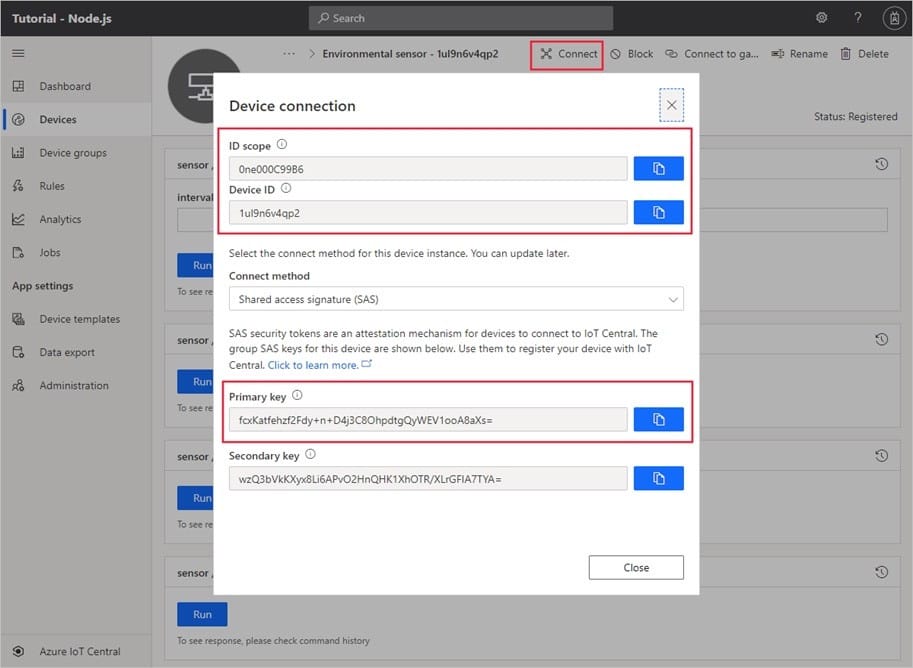Exam Details
Exam Code
:AZ-220Exam Name
:Microsoft Azure IoT DeveloperCertification
:Microsoft CertificationsVendor
:MicrosoftTotal Questions
:193 Q&AsLast Updated
:Mar 22, 2025
Microsoft Microsoft Certifications AZ-220 Questions & Answers
-
Question 111:
You have an Azure IoT solution that includes multiple Azure IoT hubs in different geographic locations and a single Device Provision Service instance. You need to configure device enrollment to assign devices to the appropriate IoT hub based on the following requirements:
1.
The registration ID of the device
2.
The geographic location of the device
The load between the IoT hubs in the same geographic location must be balanced.
What should you use to assign the devices to the IoT hubs?
A. Static configuration (via enrollment list only)
B. Lowest latency
C. Evenly weighted distribution
D. Custom (Use Azure Function)
-
Question 112:
You have an Azure IoT Central application.
You add an IoT device named Oven1 to the application. Oven1 uses an IoT Central template for industrial ovens.
You need to send an email to the managers group at your company as soon as the oven temperature falls below 400 degrees.
Which two actions should you perform? Each correct answer presents part of the solution.
NOTE: Each correct selection is worth one point.
A. Create a SendGrid account in the same resource group as the IoT Central application.
B. Add a condition that has Time Aggregation set to Off.
C. Add a condition that has Aggregation set to Minimum.
D. Add the Manager role to the IoT Central application.
E. From IoT Central, create a telemetry rule for the template.
-
Question 113:
You have 1,000 IoT devices that connect to an Azure IoT hub.
Each device has a property tag named city that is used to store the location of the device.
You need to update the properties on all the devices located at an office in the city of Seattle as quickly as possible. Any new devices in the Seattle office that are added to the IoT hub must receive the updated properties also.
What should you do?
A. From Automatic Device Management, create an IoT device configuration.
B. From the IoT hub, generate a query for the target devices.
C. Create a scheduled job by using the IoT Hub service SDKs.
D. Deploy an Azure IoT Edge transparent gateway to the Seattle office and deploy an Azure Stream Analytics edge job.
-
Question 114:
You have an existing Azure IoT hub.
You use IoT Hub jobs to schedule long running tasks on connected devices.
Which two operations do the IoT Hub jobs support directly? Each correct answer presents a complete solution.
NOTE: Each correct selection is worth one point.
A. Trigger Azure functions.
B. Invoke direct methods.
C. Update desired properties.
D. Send cloud-to-device messages.
E. Disable IoT device registry entries.
-
Question 115:
Note: This question is part of a series of questions that present the same scenario. Each question in the series contains a unique solution that might meet the stated goals. Some question sets might have more than one correct solution, while
others might not have a correct solution.
After you answer a question in this question, you will NOT be able to return to it. As a result, these questions will not appear in the review screen.
You have devices that connect to an Azure IoT hub. Each device has a fixed GPS location that includes latitude and longitude.
You discover that a device entry in the identity registry of the IoT hub is missing the GPS location.
You need to configure the GPS location for the device entry. The solution must prevent the changes from being propagated to the physical device.
Solution: You add tags to the device twin.
Does the solution meet the goal?
A. Yes
B. No
-
Question 116:
You have an Azure IoT hub that uses a Device Provisioning Service instance to automate the deployment of Azure IoT Edge devices.
The IoT Edge devices have a Trusted Platform Module (TPM) 2.0 chip.
From the Azure portal, you plan to add an individual enrollment to the Device Provisioning Service that will use the TPM of the IoT Edge devices as the attestation mechanism.
Which detail should you obtain before you can create the enrollment?
A. the scope ID and the Device Provisioning Service endpoint
B. the primary key of the Device Provisioning Service shared access policy and the global device endpoint
C. the X.509 device certificate and the certificate chain
D. the endorsement key and the registration ID
-
Question 117:
Note: This question is part of a series of questions that present the same scenario. Each question in the series contains a unique solution that might meet the stated goals. Some question sets might have more than one correct solution, while
others might not have a correct solution.
After you answer a question in this question, you will NOT be able to return to it. As a result, these questions will not appear in the review screen.
You have devices that connect to an Azure IoT hub. Each device has a fixed GPS location that includes latitude and longitude.
You discover that a device entry in the identity registry of the IoT hub is missing the GPS location.
You need to configure the GPS location for the device entry. The solution must prevent the changes from being propagated to the physical device.
Solution: You use an Azure policy to apply tags to a resource group.
Does the solution meet the goal?
A. Yes
B. No
-
Question 118:
You have an Azure IoT Central application.
You need to connect an IoT device to the application.
Which two settings do you require in IoT Central to configure the device? Each correct answer presents part of the solution.
NOTE: Each correct selection is worth one point.
A. Group SAS Primary Key
B. the IoT hub name
C. Scope ID
D. Application Name
E. Device ID
-
Question 119:
You have an existing Azure IoT hub.
You use IoT Hub jobs to schedule long running tasks on connected devices.
Which three operations do the IoT Hub jobs support directly? Each correct answer presents a complete solution.
NOTE: Each correct selection is worth one point.
A. Trigger Azure functions.
B. Invoke direct methods.
C. Update desired properties.
D. Send cloud-to-device messages.
E. Disable IoT device registry entries.
F. Update tags.
-
Question 120:
You have an Azure IoT hub.
You need to recommend a solution to scale the IoT hub automatically.
What should you include in the recommendation?
A. Create an SMS alert in IoT Hub for the Total number of messages used metric.
B. Create an Azure function that retrieves the quota metrics of the IoT hub.
C. Configure autoscaling in Azure Monitor.
D. Emit custom metrics from the IoT device code and create an Azure Automation runbook alert.
Related Exams:
62-193
Technology Literacy for Educators70-243
Administering and Deploying System Center 2012 Configuration Manager70-355
Universal Windows Platform – App Data, Services, and Coding Patterns77-420
Excel 201377-427
Excel 2013 Expert Part One77-725
Word 2016 Core Document Creation, Collaboration and Communication77-726
Word 2016 Expert Creating Documents for Effective Communication77-727
Excel 2016 Core Data Analysis, Manipulation, and Presentation77-728
Excel 2016 Expert: Interpreting Data for Insights77-731
Outlook 2016 Core Communication, Collaboration and Email Skills
Tips on How to Prepare for the Exams
Nowadays, the certification exams become more and more important and required by more and more enterprises when applying for a job. But how to prepare for the exam effectively? How to prepare for the exam in a short time with less efforts? How to get a ideal result and how to find the most reliable resources? Here on Vcedump.com, you will find all the answers. Vcedump.com provide not only Microsoft exam questions, answers and explanations but also complete assistance on your exam preparation and certification application. If you are confused on your AZ-220 exam preparations and Microsoft certification application, do not hesitate to visit our Vcedump.com to find your solutions here.

